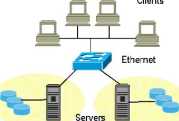9818247286
SAN Security Protocols and Mechanisms
Storage Area Networks Security Protocols and Mechanisms 1 Introduction and scope
Storage devices were up to fairly recently locked into a glass room and hence was the data stored on them enjoying privileges of the physical data center security and protection mechanisms. With a development of a Storage Area NetWork (SAN) technology, hard drives and tape drives are not necessarily directly attached to a host any morę but could be rather physically distant up to several hundred kilometers or even around a globe. Such a flexibility of logically instead of physically attached storage devices to a host madę them remotely accessible and highly available, however it brought into a consideration all security elements of the modem network environment like privacy, integrity of the data in transit and authentication of the remotely connected devices. From the data perspective, we could distinguish the storage network security, which refers to protection of the data while it is in transit versus storage data security to which we refer when the data is stored on the tapes or the hard drives. Focus of this article is to make the information security professionals aware of the new communication protocols and mechanisms for storage network security, explain threats and their security exposures as well as describe guidelines for their Solutions.
2 SAN technology and protocols overview 2.1 DAS vs. NAS vs. SAN
Historically, storage devices, such as disk drives and backup tapes, were directly attached to a host, hence the name Direct Attached Storage or DAS. This was typically performed via SCSI (Smali Computer Systems Interface) parallel bus interface with a speed of up to 320 MBps. This approach of attaching storage devices is coming from internal Computer architecture which has obviously got to its limits in several ways. Number of devices which could be attached to one bus is limited even in latest version of SCSI protocol to only 16 devices while the distances are not bigger than 15 meters. Sharing disk or tapes drives amongst multiple hosts were due to architecture of DAS impossible or reąuired specialized and typically expensive software or controllers for device sharing. On the other side, utilisation of the storage spread across the multiple servers was typically lower than on one single pool. Often necessary expansions of storage volumes and replacement of the failed hard drives have in DAS architecture frequently generated system downtimes. DAS Architecture is illustrated in Exhibit 1.
DAS
Storage
Devices

DAS
Storage
Devices
Exhibit 1: DAS Architecture.
The effort to get a better usage of storage devices by the multiple hosts has generated specialized devices for shared storage access on the file level. This architecture is commonly referred as Network Attached
Wyszukiwarka
Podobne podstrony:
SAN Security Protocols and Mechanisms_2_ Storage Area Networks Security Protocols and Mechanisms Ind
SAN Security Protocols and Mechanisms 10 networks, allowing a commodity IP network to function in a
SAN Security Protocols and Mechanisms 12 One host or storage device could also belong to a multiple
SAN Security Protocols and Mechanisms 20 6 Futurę directions Storage security is still evolving topi
SAN Security Protocols and Mechanisms Storage or shortly NAS. NAS architecture consist of a dedicate
SAN Security Protocols and Mechanisms 3.3 Access Control and Authentication Another critical aspect
SAN Security Protocols and Mechanisms 13 4.1.3 Fibrę Channel Security Protocols To address additiona
SAN Security Protocols and Mechanisms 14 4.1.3.1.2 Fibrę Channel Authentication Protocol Fibrę Chann
SAN Security Protocols and Mechanisms 15 4.1.3.2FC-SP per frame confidentiality and integrity Recogn
SAN Security Protocols and Mechanisms 16 FC-2 Payload: 0-528 Transmission
SAN Security Protocols and Mechanisms 17 • Data Origin Authentication The IPsec re
SAN Security Protocols and Mechanisms endpoints can be determined, the true source and destination e
SAN Security Protocols and Mechanisms 19 An iSCSI node must also support Internet Key Exchange (IKE)
SAN Security Protocols and Mechanisms Index of Exhibits Exhibit 2: NAS
SAN Security Protocols and Mechanisms The invention of a Fibrę Channel (FC) has opened a complete ne
SAN Security Protocols and Mechanisms iSCSI enables SCSI-3 commands to be encapsulated in TCP/IP pac
SAN Security Protocols and Mechanisms Exhibit 6: Fibrę Channel Protocol Stack The lowest level (FC-0
SAN Security Protocols and Mechanisms FCIP transports Fibrę Channel data by creating a tunnel betwee
The following apply to all types of network both local area networks and wide area networks, m both
więcej podobnych podstron